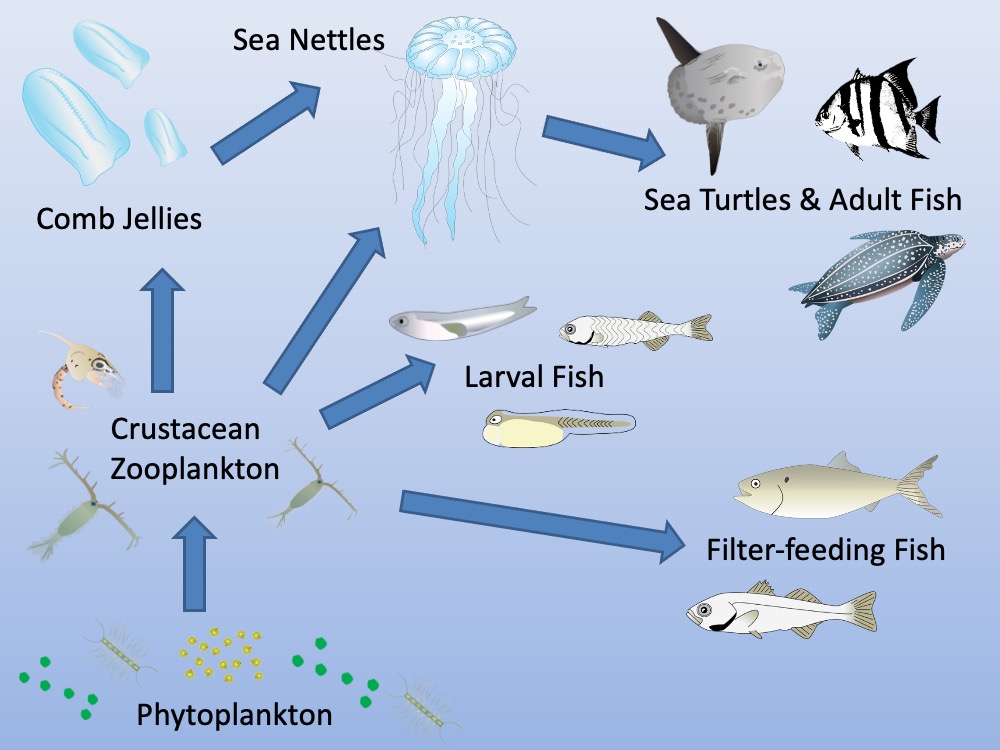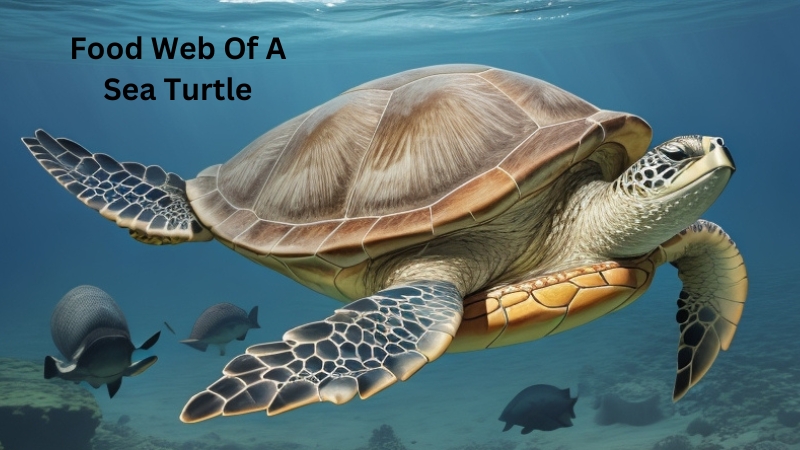Food Web Of A Sea Turtle
Today we discuss the Food Web Of A Sea Turtle. As we delve into the depths of the sea turtle’s food web, we’ll uncover the vital role these ancient reptiles play in maintaining the balance of marine life. From tiny zooplankton to large predatory fish, each piece of the puzzle contributes to the survival of these gentle giants. Brace yourself for an adventure into the depths of the ocean to discover the surprising connections that sustain sea turtles.
Join us on this exciting exploration of the food web of a sea turtle, where we’ll unravel the intricate relationships between these magnificent creatures and the abundance of marine life that surrounds them. Get ready to be amazed by the astonishing interdependencies and the natural wonders of the ocean that make this food web so captivating. Let’s dive in and unlock the mysteries of the sea turtle’s banquet!

Exploring the Food Web of a Sea Turtle: A Fascinating Look into Marine Ecosystems
The sea turtle, a true marvel of the ocean, plays a critical role in the intricate food web of marine ecosystems. From its diet to its position as both predator and prey, the sea turtle’s place in the ocean’s delicate balance is vital. In this article, we will delve into the depths of the sea turtle’s food web, uncovering the interconnected relationships between various species and the crucial role these ancient reptiles play in maintaining the health of our oceans.
The Sea Turtle’s Prized Prey: Jellyfish and Sea Sponges
Sea turtles have a diverse diet, but two of their favorite delicacies are jellyfish and sea sponges. Sea turtles possess specialized jaws for efficiently consuming jellyfish, a food source that is abundant but can be challenging to catch. The jellyfish population is controlled by sea turtles, as they help prevent these gelatinous creatures from proliferating beyond sustainable levels.
On the other hand, sea sponges are a nutritious and important part of a sea turtle’s diet. These filter-feeding organisms are essential for maintaining water clarity and filtering out impurities, contributing to overall ecosystem health. As sea turtles feed on sea sponges, they contribute to a balanced and thriving marine environment.
Crustaceans: Providing Sustenance and Supporting the Food Chain
Another significant component of the sea turtle’s food web is crustaceans. These include crabs, lobsters, and shrimp, which serve as an essential source of sustenance for sea turtles. As opportunistic foragers, sea turtles rely on these small but abundant creatures to sustain their energy needs. By keeping crustacean populations in check, sea turtles indirectly contribute to the preservation of habitats and other species that share these resources.
Furthermore, the presence of sea turtles directly affects the foraging behavior of crustaceans. Their mere presence can influence the behavior of these creatures, creating a cascading effect on the entire food web. Sea turtles’ predation on crustaceans alters the dynamics of marine ecosystems, allowing for the survival of other species that depend on these resources.

The Oceanic Red Carpet: Migration Routes and Foraging Grounds
Sea turtles are renowned for their impressive migration patterns, covering vast distances in search of food and nesting sites. These migrations are not only awe-inspiring but also crucial for maintaining the balance of oceanic food webs.
By traversing different regions of the ocean, sea turtles facilitate the distribution of vital nutrients, impacting the productivity and health of various marine ecosystems.
During their migrations, sea turtles target specific foraging grounds where food resources are abundant. These locations, often characterized by nutrient-rich upwellings or coral reef ecosystems, attract a multitude of species and foster the development of thriving food webs.
As apex predators, sea turtles keep these food webs in check, preventing imbalances and ensuring the sustainability of the entire ecosystem.
Sea Turtles as Prey: The Impact of Predators in the Food Web
While sea turtles play a significant role as predators in marine food webs, they also become prey themselves. Various predators, such as sharks and killer whales, target sea turtles for their substantial energy value.
These interactions between predators and sea turtles contribute to the intricate web of interactions within marine ecosystems.
In addition to natural predators, human activities pose a significant threat to sea turtles. Pollution, climate change, and habitat destruction are just a few of the challenges that sea turtles face.
By understanding the vulnerabilities of sea turtles as prey, we can gain valuable insights into the impact of human actions on the delicate balance of the food web and take measures to protect these vulnerable creatures.
The Ripple Effect: Sea Turtles and the Preservation of Ecosystem Health
The presence of sea turtles in marine ecosystems goes beyond their direct impact on the food web. These ancient reptiles act as indicators of ecosystem health, reflecting the overall well-being of the ocean.
By monitoring sea turtle populations, scientists can gauge the status of habitats, prey availability, and the impact of human activities.
Furthermore, sea turtles contribute to the resilience and adaptation of marine environments. As they migrate across vast distances, they facilitate genetic transfer between populations, promoting diversity and the ability to withstand environmental changes.
Their presence maintains the balance of ecosystems, ensuring the sustainable coexistence of multiple species.
Protecting the Guardians of the Sea: Conservation Measures and Future Outlook
Recognizing the vital role sea turtles play in marine food webs, conservation efforts have been implemented worldwide. Governments, organizations, and individuals are working together to protect nesting sites, reduce pollution, implement sustainable fishing practices, and raise awareness about the importance of these ancient reptiles.
However, much work remains to be done. Climate change, plastic pollution, and habitat destruction continue to threaten sea turtle populations.
To secure the future of these incredible creatures and the health of marine ecosystems, it is crucial to support conservation initiatives, advocate for stronger environmental regulations, and educate others about the significance of the sea turtle’s place in the food web.
Key Takeaways: Food Web of a Sea Turtle
- A sea turtle’s food web consists of various organisms it interacts with for survival.
- Sea turtles are primarily herbivores, feeding on seagrasses and algae.
- Some sea turtle species also consume jellyfish, sponges, and mollusks.
- Sea turtles can be preyed upon by sharks, large fish, and even birds.
- The health of a sea turtle’s food web is crucial for its overall well-being.
Faqs for Food Web Of A Sea Turtle:
Sea turtles have a varied diet depending on their species. Some sea turtles, like the green sea turtle, are herbivores and primarily eat seagrasses and algae. Other species, such as the loggerhead and leatherback turtles, are omnivores and eat a mix of plants and animals.
They consume jellyfish, crabs, shrimp, and even mollusks. They play a crucial role in maintaining the balance of their marine ecosystems by keeping populations of these animals in check.
In addition to their regular diet, sea turtles also accidentally ingest plastics and other marine debris, which can have harmful effects on their health. These are unintentional additions to their diet and can pose significant threats to their survival.
Sea turtles use various methods to find their food. Some species, like the green sea turtle, rely on sight to search for seagrasses and algae in shallow coastal areas.
They have excellent vision and can spot their food easily. Other species, like the loggerhead turtle, have a keen sense of smell and can detect the scent of their prey, especially when hunting animals like jellyfish.
Sea turtles are also known for their ability to navigate long distances to find feeding grounds. They use magnetic fields and the Earth’s natural cues, such as currents and temperature changes, to locate areas abundant in food.
It’s truly fascinating how these marvelous creatures find their way around the vast oceans!
Sea turtles are important members of the marine food web, but they are not at the top of the food chain. As predators, sea turtles have natural predators of their own, such as sharks and killer whales, especially when they are younger and more vulnerable. These larger predators often target sea turtles as an easy food source.
However, sea turtles also play a critical role as prey. For example, when sea turtles die, their decomposing bodies provide important nutrients for other organisms in the food chain. This process helps sustain the health and diversity of the marine ecosystem.
Sea turtle populations have a significant impact on the food web. As predators, they control the populations of their prey, helping to maintain a balance in the ecosystem. Without sea turtles, certain species like jellyfish could multiply unchecked, leading to imbalances and disruptions in the food chain.
Additionally, sea turtles transport nutrients between different ecosystems. When they migrate and feed in one area, they may become a source of nutrients for other ecosystems when they defecate or return to the nesting beaches and contribute to the local vegetation. This movement of nutrients enhances biodiversity and supports the health of various habitats along their migratory routes.
Human activities can have both direct and indirect impacts on the sea turtle’s food web. Pollution, such as marine debris and oil spills, can harm sea turtles directly by entangling or poisoning them.
These pollutants also affect the sea turtle’s prey, disrupting their availability and causing imbalances in the food web.
Overfishing is another concern. When certain prey species are overfished, it can lead to a scarcity of food for sea turtles, affecting their ability to survive and reproduce.
Climate change is also a significant threat, causing shifts in ocean currents and affecting the distribution of food sources for sea turtles. Conservation efforts are vital in protecting the sea turtle’s food web and ensuring their continued survival in their natural habitats.
The Ocean Food Chain | Turtle’s Guide to the Pacific | BBC Earth
Summary:
Sea turtles have a big impact on the food web of the ocean. They eat sea grass and jellyfish and are also preyed upon by sharks. When sea turtles migrate to lay their eggs on beaches, they transfer nutrients from the ocean to land. This benefits other animals and plants. However, sea turtles are facing threats from pollution and habitat destruction. We need to protect these amazing creatures to ensure the health of our oceans and the balance of the food web.
Sea turtles play a vital role in maintaining the delicate balance of the ocean’s food web. By eating sea grass and jellyfish, they help control their populations. Their migration and nesting habits also contribute to nutrient transfer between the ocean and land. It’s important for us to take action to protect sea turtles and their habitats, as they are facing numerous threats. By doing so, we can help preserve the health of our oceans and the diverse ecosystems they support.

